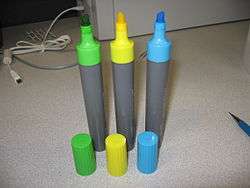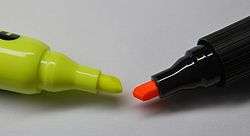Highlighter

A highlighter is a type of writing device used to draw attention to sections of text by marking them with a vivid, [translucent]colour.[1] A typical highlighter is fluorescent yellow, coloured with pyranine. Different compounds, such as rhodamines (Rhodamine 6GD, Rhodamine B) are used for other colours.[2]
History
A highlighter is a felt tip marker filled with transparent fluorescent ink instead of black or opaque ink. The first highlighter was invented by Dr. Frank Honn in 1963[3] and produced by Carter's Ink Company, using the trademarked name HI-LITER (not Sharpie) . Avery Dennison Corporation now owns the brand, having acquired Carter's Ink Company in 1975.[4]
Schwan-Stabilo has been producing felt tip writing devices since 1971. It is hailed as the European product leader of manufacturing highlighters. In 2003, the company changed its name to Stabilo International.[5]
Styles

Many highlighters come in bright, often fluorescent and vibrant colors. Being fluorescent, highlighter ink glows under black light.[6] The most common color for highlighters is yellow, but they are also found in orange, red, pink, purple, blue, and green varieties. Some yellow highlighters may look greenish in colour to the naked eye. Yellow is the preferred color to use when making a photocopy as it will not produce a shadow on the copy. Yet, the use of different colour highlighters simultaneously can systematically make information even more organized and readable and in high contrast.
Highlighters are available in multiple forms, including some that have a retractable felt tip or an eraser on the end opposite the felt. Other types of highlighters include the trilighter, a triangularly-shaped pen with a different-coloured tip at each corner, and ones that are stackable. There are also some forms of highlighters that have a wax-like quality similar to an oil pastel.
"Dry highlighters" (occasionally called "dry line highlighters") have an applicator that applies a thin strip of highlighter tape (physically similar to audio tape) instead of a felt tip. Unlike standard highlighters, they are easily erasable. They are different from "dry mark highlighters", which are sometimes advertised as being useful for highlighting books with thin pages.
"Gel highlighters" contain a gel stick rather than a felt tip. The gel does not bleed through paper or become dried out in the pen as other highlighters' inks may.
"Liquid Highlighters" in a range of colours are also available, and because they put more ink on a page when highlighting, make words stand out more than with non-liquid types. Also the fact that more highlighting ink is put on the page with liquid highlighters means that the highlighting ink is much more resistive to fading with age.
Other uses

Some word processing software can simulate highlighting by using a technique similar to reverse video on some terminals.
Example of highlighting on a word processor.
See also
- Sanitization (classified information)—using black "highlighter" to hide classified information.
References
- ↑ WO 2005042654, Schmid, "Ink compositions for use in highlighter markers and associated methods", published 12 May 2005
- ↑ Brunning, Andy (2015-01-22). "The Chemistry of Highlighter Colours" (PNG). Compound Interest. Retrieved 2016-04-18.
- ↑ Francis Honn Obituary
- ↑ Hilary, Greenbaum; Rubinstein, Dana (2012-01-22). "WHO MADE THAT? The Hand-Held Highlighter". The New York Times Sunday Magazine. p. MM20. Retrieved 2012-01-26.
- ↑ "Highlighters or Hi-liters? Learn About the History of Fluorescent Markers". opisina. Retrieved 20 October 2014.
- ↑ Highlighter Ink Glowing Under a Black Light
External links

